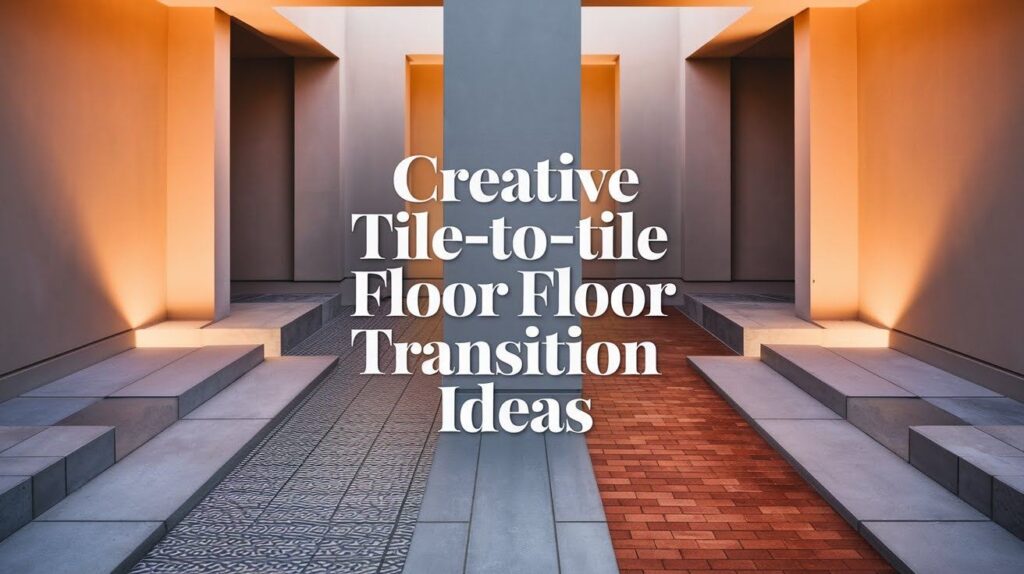After working with countless flooring projects over the years, I can tell you that tile transitions make or break a space. They’re not just functional necessities. They’re design opportunities.
These 17 transition ideas will transform how your floors flow from room to room. Your guests will notice. Your home value will increase. Most importantly, you’ll feel confident about every step you take.
Start small. Pick one transition that speaks to you. Test it in a less visible area first. Once you see the difference it makes, you’ll want to upgrade every transition in your home.
Your floors tell a story. Make sure it’s a good one.
List of 17 Creative Tile-to-Tile Floor Transition Ideas
Your floors don’t have to be boring. They shouldn’t end abruptly either.
Smart transitions make your home feel intentional. They solve practical problems too. Let’s look at 17 ways to connect your tiles with style.
1. Metal Transition Strips
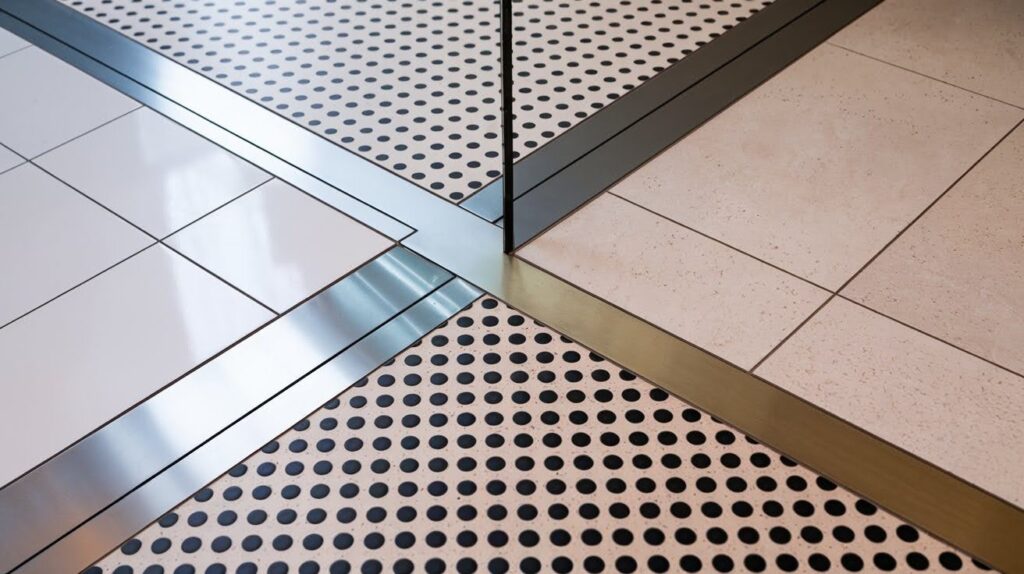
Aluminum strips are workhorses that handle foot traffic without complaints. Brass adds warmth to any room while maintaining durability.
Installation takes just minutes, making this one of the most practical solutions available. These strips come in various finishes to match your hardware.
They protect tile edges from chipping and cracking. Your floors get instant polish with minimal investment. Perfect for high-traffic areas that need reliable performance daily.
2. Marble or Stone Thresholds
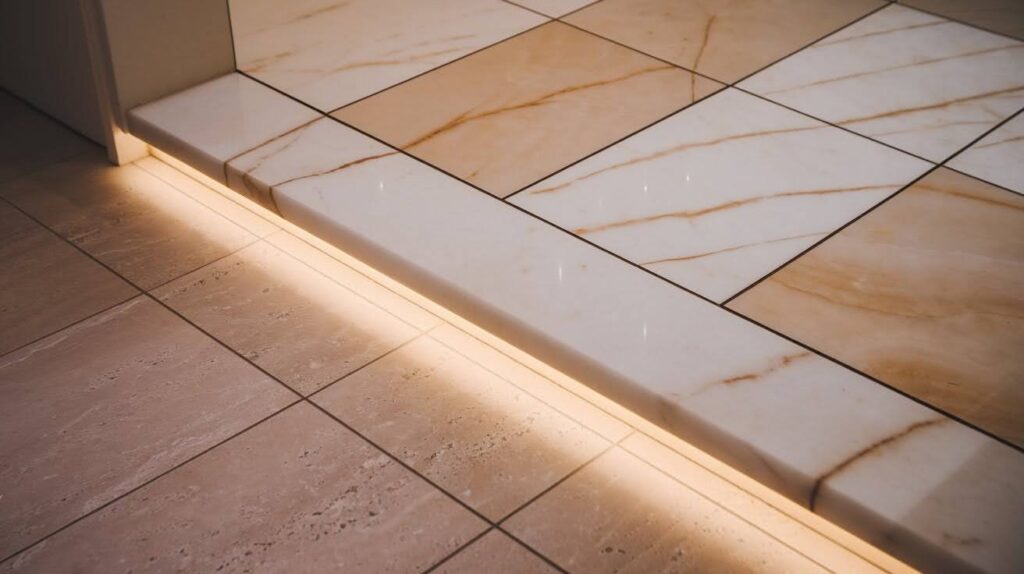
Nothing says luxury like natural stone connecting your spaces beautifully. Marble thresholds work perfectly in bathrooms and kitchens where moisture resistance matters most. They’re incredibly tough and completely timeless in visual appeal.
Each piece has unique veining that adds character to your floors. Stone options include granite, travertine, and slate for different aesthetics.
They handle temperature changes without cracking or shifting. Every step feels special when you walk across genuine stone materials.
3. Wood Inlay Borders

Wood softens hard tile surfaces while bringing natural warmth to cold spaces effectively. Rustic homes love this organic look that bridges different flooring materials seamlessly.
Transitional styles embrace wood’s versatility in connecting various room functions. Your feet appreciate the softer landing between rooms during daily activities. Choose from oak, walnut, cherry, or exotic species for a unique character.
Proper sealing protects wood from moisture damage in wet areas. Installation requires precision cutting but delivers stunning visual results.
4. Mosaic Tile Borders
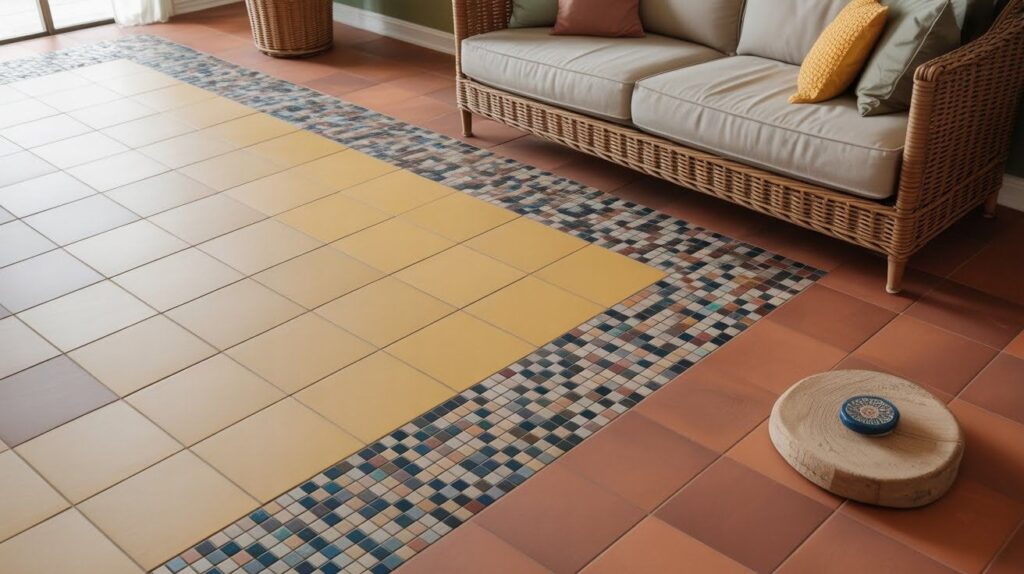
Small tiles make big visual statements while separating busy patterns beautifully throughout spaces. Mix colors and play with textures to create custom designs that reflect personality.
These borders become artistic focal points that define different zones within rooms. Glass mosaics reflect light for added sparkle throughout your living space.
Stone versions provide natural texture and earthy appeal for organic aesthetics. Ceramic options offer endless color combinations at budget-friendly prices. Installation allows creative freedom in developing unique pattern creations.
5. Geometric Transition Patterns
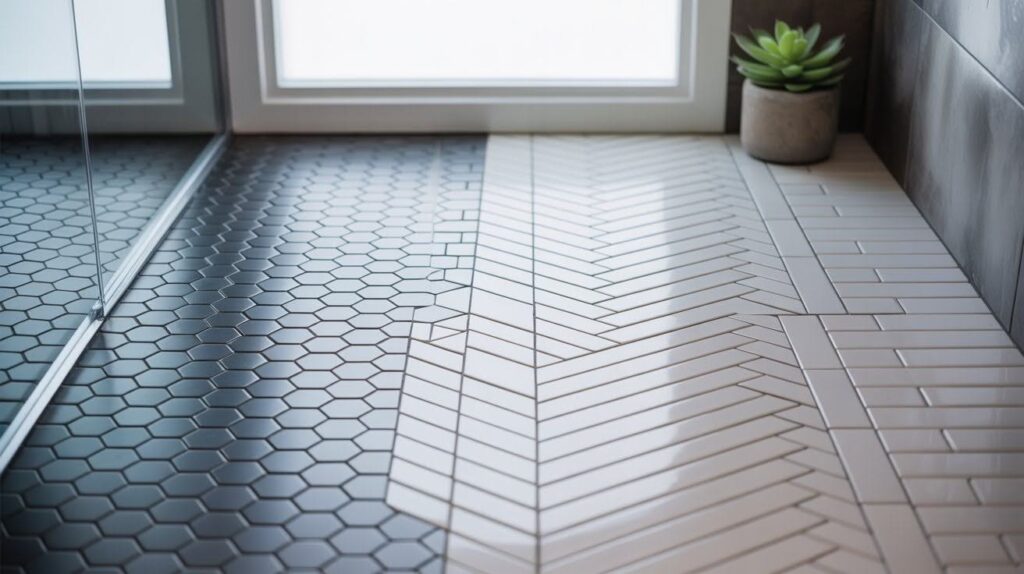
Hexagons are having a major design moment in contemporary home styling right now. Chevron patterns never go out of style in any home design approach. Herringbone adds instant sophistication to basic tile layouts without major expense.
Pick your favorite geometry to create visual interest between different spaces. These patterns work with any tile size or material type available.
They add movement to static floors while maintaining clean, organized lines. Installation requires careful planning but delivers professional results that impress visitors.
Wait, there’s more.
6. Grout Color Change
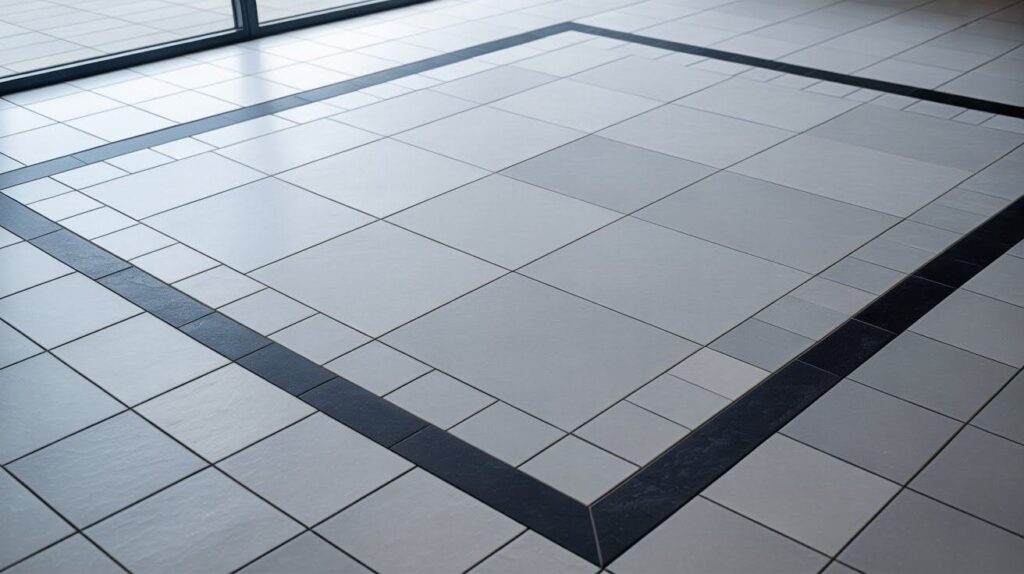
Sometimes simple solutions work best for creating clear visual divisions between tile areas. Different grout colors separate spaces without requiring extra materials or significant expense.
Dark grout defines light tiles, while light grout softens dark tile appearances. This technique costs almost nothing but delivers maximum visual impact for homeowners. Choose contrasting colors for bold statements or subtle shades for gentle transitions.
Maintenance remains simple with standard cleaning routines and common household products. Professional installation ensures consistent color application throughout the entire transition area.
7. Pebble or River Rock Strip
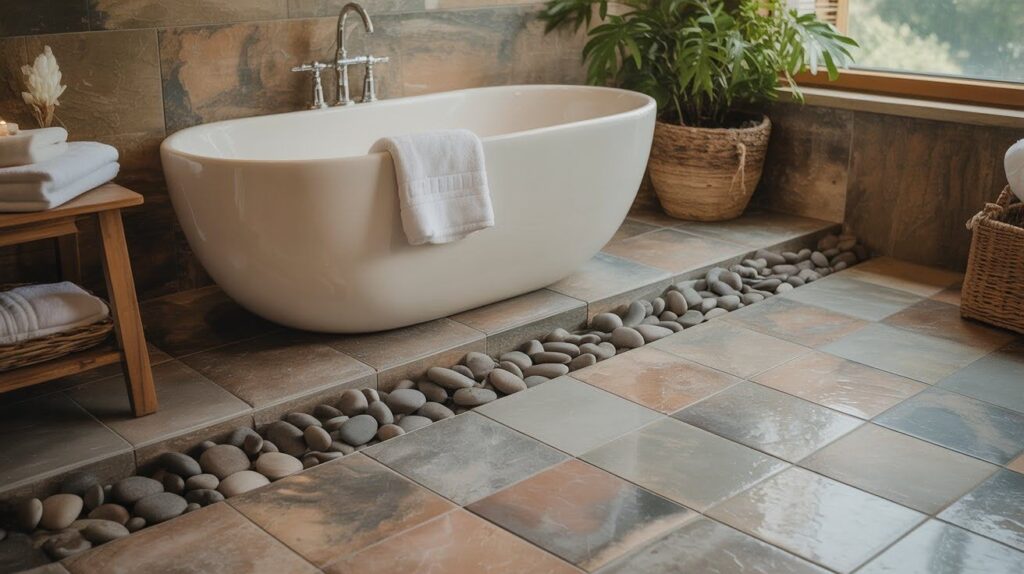
Bring the spa experience home with natural stone textures underfoot in transition areas. These organic materials feel amazing while creating unique zones between different spaces.
Bathrooms become personal retreats where stress melts away with every step taken. River rocks provide gentle massage effects during daily foot traffic patterns. Pebbles come in various sizes and colors for completely custom aesthetic looks.
Proper installation prevents shifting and maintains smooth, safe surfaces for walking. Sealed stones resist moisture and staining in wet bathroom and kitchen areas.
8. Decorative Tile Inserts
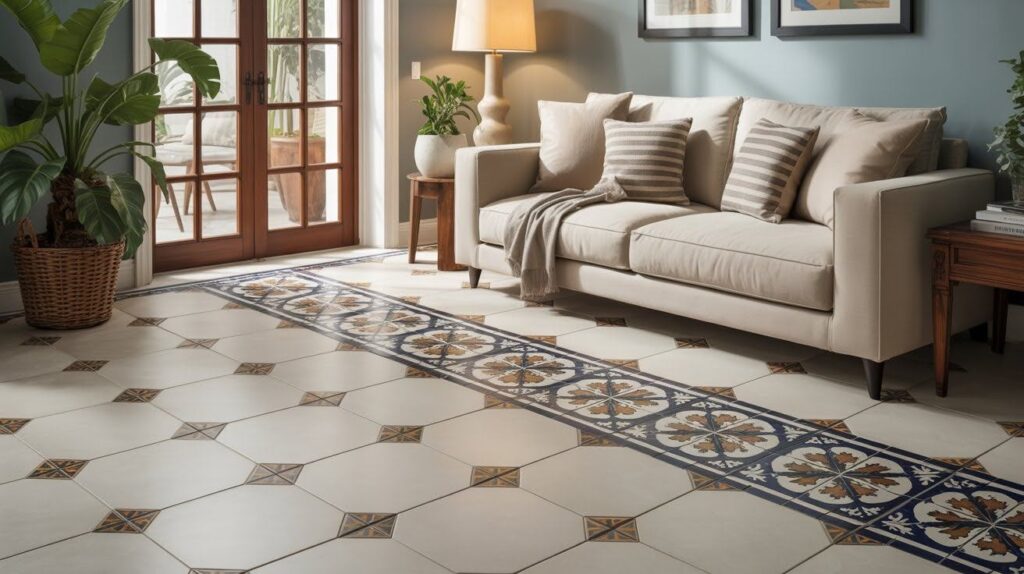
Custom designs tell your personal story through carefully planned flooring artistry and craftsmanship. Hand-painted tiles become instant conversation starters in any room of your home.
Plain floors gain a distinctive personality while your space develops a unique, memorable character. Artisan tiles showcase traditional craftsmanship that mass production simply cannot match effectively.
These inserts work as transition lines or standalone decorative features throughout spaces. Color coordination ties different tile areas together seamlessly for a cohesive room design.
Professional installation ensures proper alignment and long-lasting durability for years of enjoyment.
9. Contrasting Tile Band
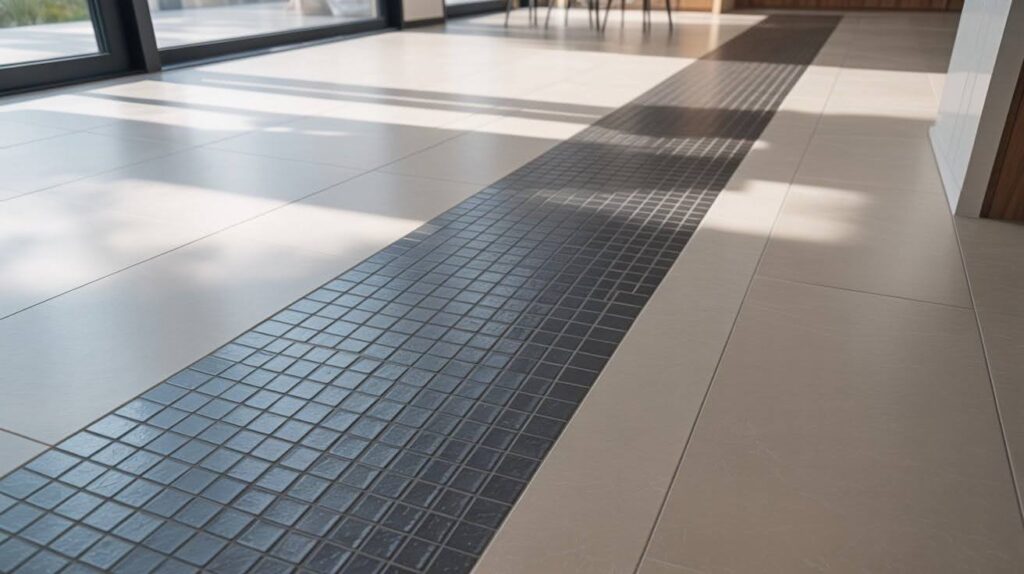
Dark bands ground light floors while creating strong visual anchors in open spaces. Light strips brighten dark areas and add contemporary flair to traditional designs. Open floor plans need a clear definition between different functional areas within homes.
Bold contrasts deliver immediate visual impact without overwhelming the overall space design. These bands guide foot traffic naturally through your home’s daily circulation patterns.
Width variations create different visual effects and practical benefits for homeowners. Color selection significantly affects the overall room mood and spatial perception throughout.
10. Glass Tile Accents
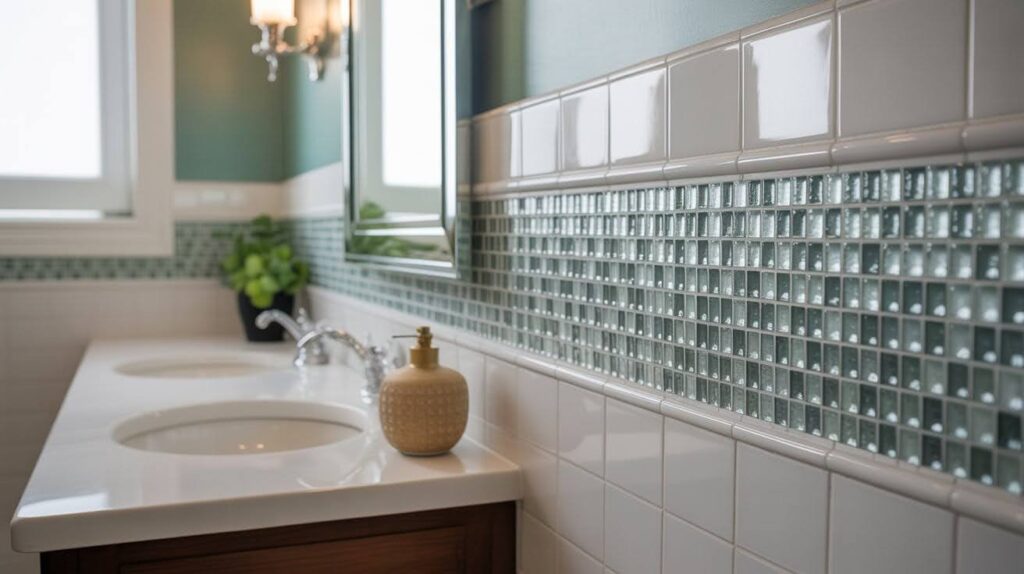
Glass catches natural light beautifully while reflecting your sophisticated design taste throughout spaces. Modern homes need this brilliant shine that changes dynamically throughout the day.
These accents work perfectly in wet areas without any moisture-related concerns. Frosted glass provides subtle texture while clear versions offer maximum light-reflecting sparkle. Colored glass introduces vibrant hues that energize neutral tile color palettes effectively.
Recycled glass options support environmental responsibility in contemporary design choices today. Easy maintenance keeps glass surfaces looking pristine with simple, routine cleaning procedures.
11. Curved Transition Lines
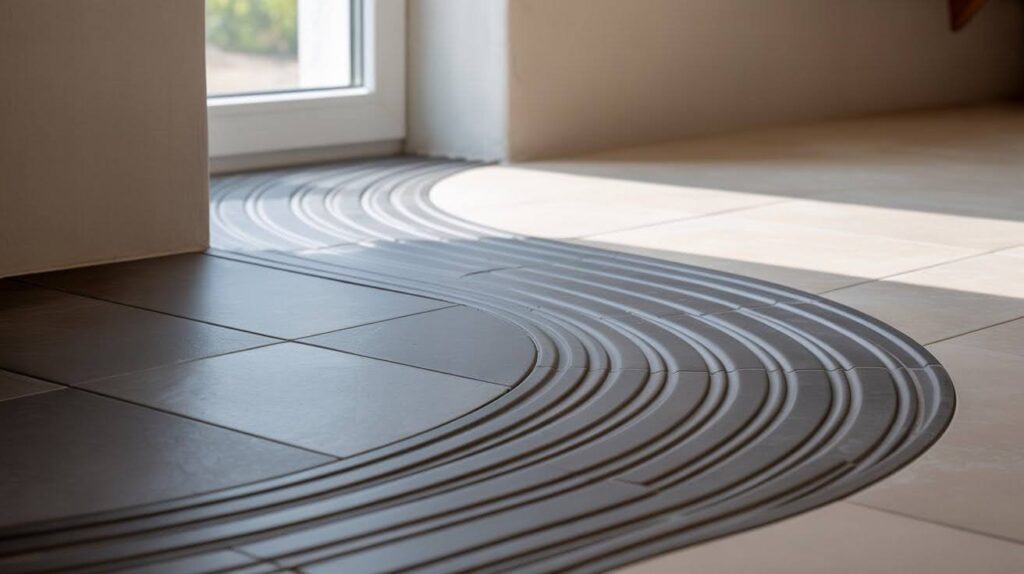
Straight lines feel rigid, while curves feel naturally organic and flowing throughout spaces. They soften harsh, angular edges that can make rooms feel uncomfortable. Curved transitions guide foot traffic gently through your home’s natural circulation patterns.
These flowing lines break up monotonous rectangular tile patterns very effectively. Installation requires skilled craftsmen who understand proper curve execution and planning techniques.
The visual effect creates movement and energy in otherwise static floor designs. Maintenance follows standard tile care routines without requiring any special cleaning procedures.
12. Pattern-to-Pattern Blend
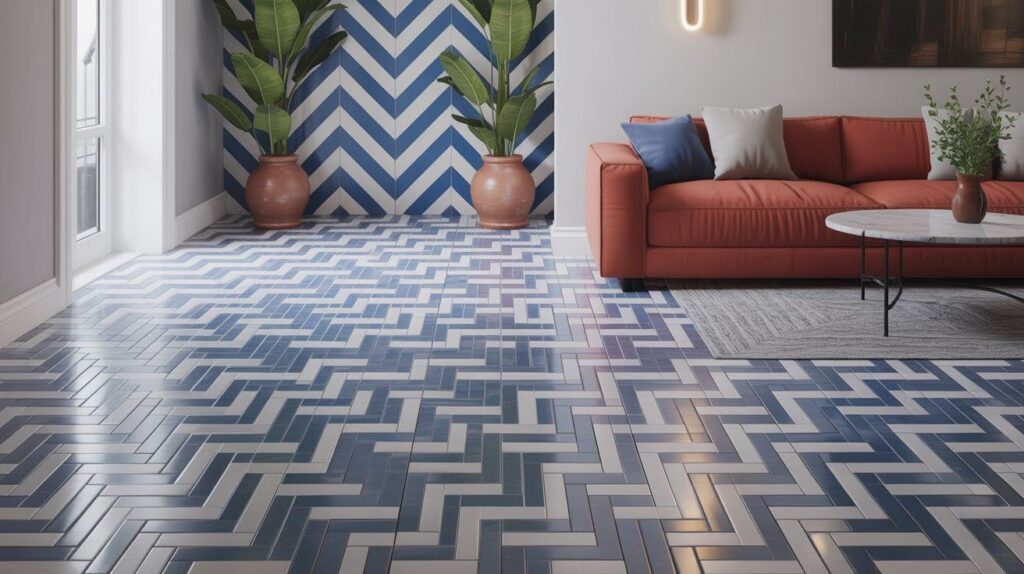
Two bold patterns can coexist successfully when complementary colors tie them together harmoniously. The secret lies in balancing busy designs with visual rest areas strategically. Your eye needs comfortable places to pause between competing pattern elements throughout.
Color coordination prevents visual chaos while maintaining individual pattern identity and character. Scale differences help distinguish between pattern types without creating design conflict.
Professional design consultation ensures successful pattern combinations that work effectively long-term. Installation requires careful planning to align patterns properly at critical transition points.
13. Flush Transition with No Divider
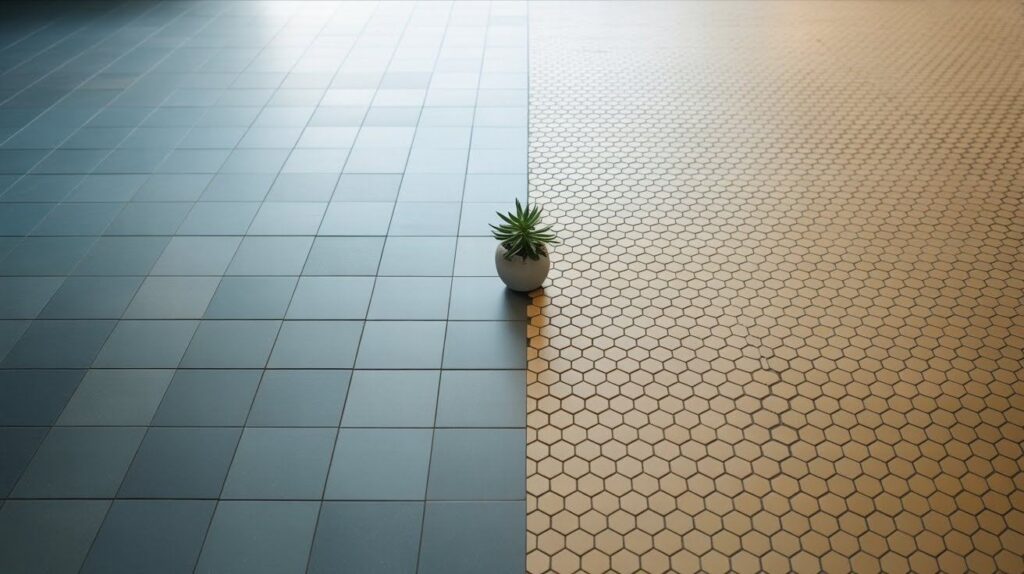
Minimalists love clean lines that create seamless visual flow between different spaces effectively. These transitions require perfect installation precision to achieve truly professional visual results.
The effect makes floors appear to flow like continuous surfaces throughout homes. Height matching becomes critical for both visual appearance and daily safety considerations.
Grout lines must align perfectly to maintain the illusion of complete continuity. This technique works best with similar tile materials and coordinating color schemes. Professional installation investment pays off in long-term visual satisfaction and home value.
14. Raised Threshold Step
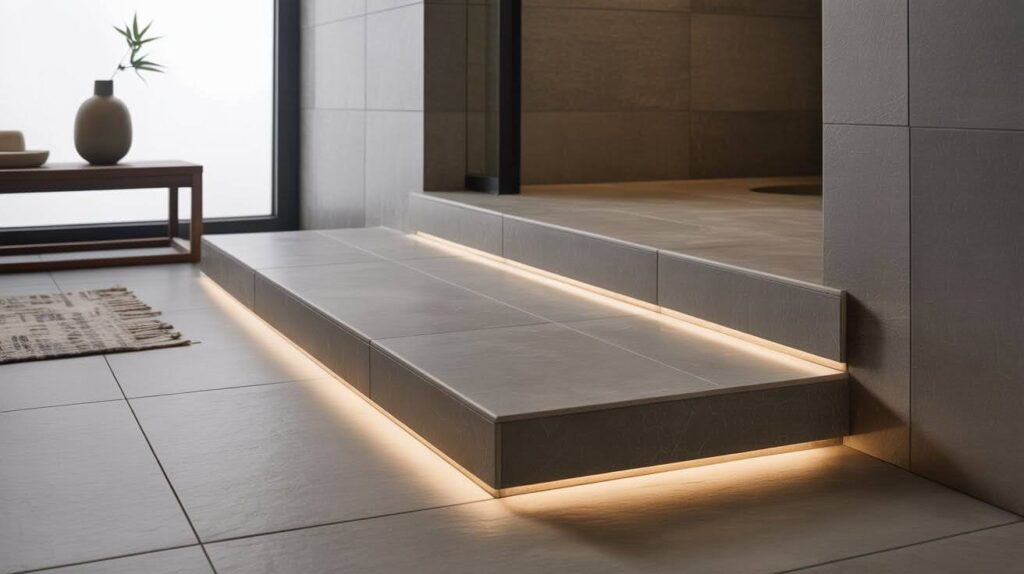
Wet areas need clear boundaries that raised steps provide naturally and very effectively. They add dimensional visual interest to otherwise flat floor surfaces throughout homes.
Function meets form perfectly in these practical yet visually attractive design solutions. Height variations create visual separation while maintaining accessible passage between different rooms.
These steps can incorporate LED lighting for safety and dramatic nighttime effects.
Material choices range from matching tiles to contrasting accent materials for variety. Proper drainage integration prevents water damage in bathroom and kitchen applications successfully.
15. Metal-to-Tile Accent Strip
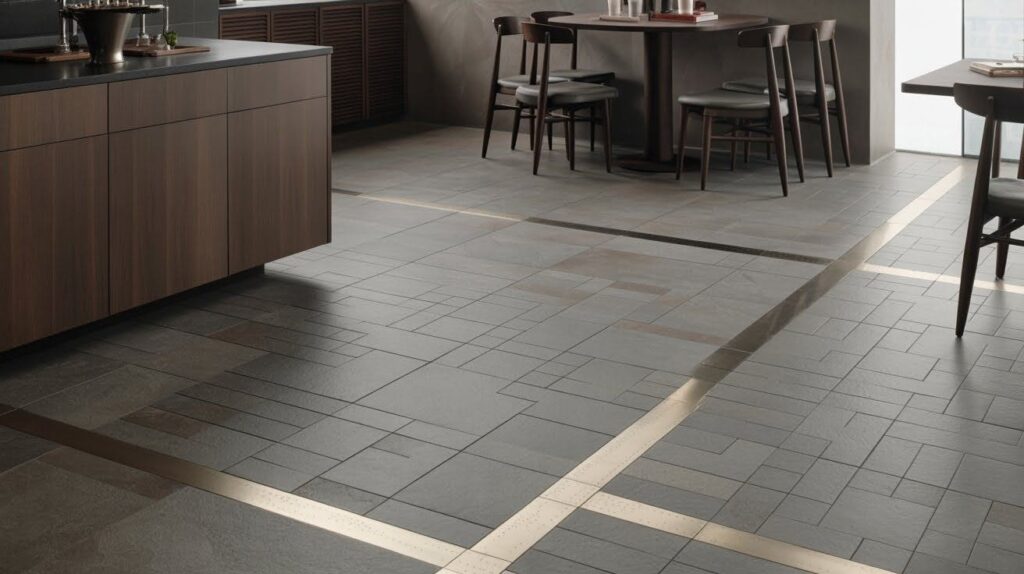
Industrial aesthetics meet residential comfort in these striking modern design combinations successfully. Steel strips look surprisingly warm when properly integrated with natural tile materials.
Modern homes embrace this material contrast that creates sophisticated edge appeal throughout. Stainless steel resists corrosion while brass develops beautiful patina over an extended time.
These strips handle heavy foot traffic without showing wear patterns or damage. Width variations create different visual impacts, from subtle accents to bold statements. Professional installation ensures proper expansion joint accommodation for long-term structural durability.
16. Tile Medallion or Centerpiece

Entryways deserve special treatment that medallions provide through memorable first impressions for visitors. Hallways become gallery spaces where every step feels deliberately important and considered.
These focal points anchor room designs while creating natural transition zones effectively. Custom medallions reflect personal style preferences and meaningful family heritage elements beautifully.
Pre-made options offer professional quality at accessible price points for most budgets. Installation requires precise centering and careful pattern alignment for optimal visual impact. Maintenance follows standard tile care routines with attention to intricate design details.
17. Custom Artistic Borders
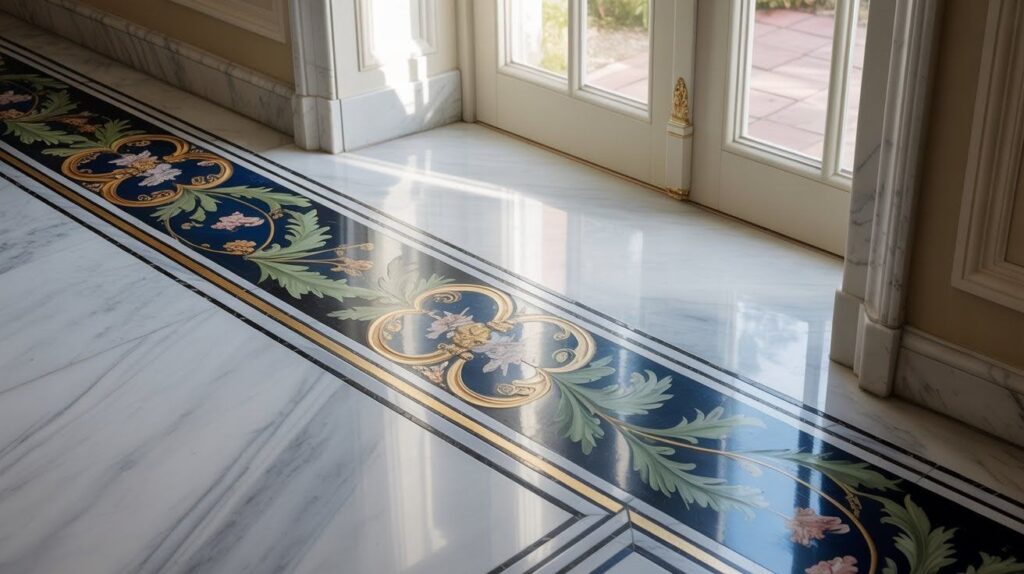
Artisan tiles represent long-term investments that turn floors into genuine masterpieces of craftsmanship. Hand-painted details create irreplaceable character that mass production cannot duplicate or replicate.
Your home becomes truly unique with one-of-a-kind artistic elements throughout the design. Local artists can create custom pieces that reflect regional culture and preferences.
These borders tell stories through imagery, patterns, and meaningful color combinations. Proper installation protects artistic investment while showcasing craftsmanship appropriately for maximum impact.
Maintenance preserves artistic integrity for future generations to appreciate and enjoy fully.
Tips for Choosing the Right Tile Transition
Not all transitions work in every situation. Smart choices save money and headaches later.
- High-traffic areas need durable materials like metal strips or stone. Delicate mosaics work better in quiet bedrooms than in busy hallways.
- Match transitions with your home’s style for visual consistency. Modern spaces prefer clean lines while traditional homes suit natural materials.
- Balance creativity with practical maintenance needs before deciding. Beautiful designs often require more cleaning and special care products.
- Consider your lifestyle when choosing materials for daily use. Families with kids and pets need tougher options than adult-only homes.
- Simple metal strips work as DIY weekend projects. Complex patterns and curves need professional installation to avoid costly mistakes.
- Professional installation costs more but prevents expensive disasters. Specialized techniques ensure proper support and perfect alignment for lasting results.
Conclusion
After years of installing floors, I’ve seen how the right transition changes everything. These 17 ideas give you options for every space and budget.
Good transitions do more than look pretty. They prevent trips and falls. They protect your tile edges from damage. They make cleaning easier between different floor types.
Don’t settle for basic metal strips when you could have something special. Custom artistic borders or curved lines cost more upfront but add serious value to your home.
Start with one room. See how it feels. Then expand your vision to other spaces.
Your floors should tell your story. Make every transition count.
Frequently Asked Questions
What is the most durable tile transition for high-traffic areas?
Metal transition strips, especially aluminum or stainless steel, offer the best durability for busy spaces. They resist wear, handle heavy foot traffic, and protect tile edges from chipping or cracking over time.
Can I install tile transitions myself or do I need a professional?
Simple metal strips and basic threshold installations work well as DIY projects for most homeowners. Complex designs like curved transitions, flush installations, or natural stone require professional expertise to ensure proper alignment and structural support.
How do I choose the right transition style for my home?
Match your transition with your overall design aesthetic and consider the room’s function and traffic levels. Modern homes suit clean metal strips while traditional spaces look better with wood inlays or natural stone options.
What’s the cost difference between basic and custom tile transitions?
Basic metal strips cost $3-8 per linear foot while custom artistic borders or natural stone can range $15-50 per foot. Installation complexity and material quality significantly impact the final price for your project.
Do tile transitions require special maintenance or cleaning?
Most transitions follow standard tile cleaning routines with regular mopping and occasional deep cleaning. Natural materials like wood or unsealed stone may need special cleaners or periodic sealing to maintain their appearance and durability.

